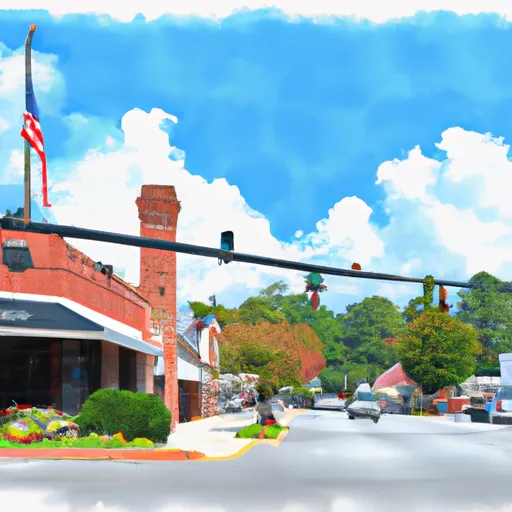-
 Snoflo Premium
Snoflo Premium
Get unlimited access to all our content
With no Ad interruptions! - Start Your Free Trial Login with existing account
Cleveland
Eden Index
Climate
7.1
•
Recreation
5.5
•
Community
2.3
•
Safeguard
5.3/10

Cleveland, Georgia is a small town nestled in the foothills of the Blue Ridge Mountains. The climate in Cleveland is generally mild with warm summers and cool winters. The town is situated near the headwaters of the Chattahoochee River, which provides a source of fresh water for the surrounding area. Additionally, several creeks and streams flow throughout the town, contributing to the hydrology of the area. Outdoor recreation opportunities in Cleveland include hiking, fishing, and camping in nearby national forests such as Chattahoochee-Oconee National Forest and the Appalachian Trail. Visitors can also explore local attractions such as BabyLand General Hospital, the home of Cabbage Patch Kids, and the charming downtown area with unique shops and restaurants.
What is the Eden Index?
The Snoflo Eden Index serves as a comprehensive rating system for regions, evaluating their desirability through a holistic assessment of climate health, outdoor recreation opportunities, and natural disaster risk, acknowledging the profound impact of these factors on livability and well-being.
Climate Health Indicator (CHI): 7.1
Cleveland receives approximately
1607mm of rain per year,
with humidity levels near 82%
and air temperatures averaging around
14°C.
Cleveland has a plant hardyness factor of
7, meaning
plants and agriculture in this region tend to thrive during the non-winter months.
By considering the ideal temperature range, reliable water supplies, clean air, and stable seasonal rain or snowpacks, the Climate Health Indicator (CHI) underscores the significance of a healthy climate as the foundation for quality living.
A healthy climate is paramount for ensuring a high quality of life and livability in a region, fostering both physical well-being and environmental harmony. This can be characterized by ideal temperatures, reliable access to water supplies, clean air, and consistent seasonal rain or snowpacks.
Weather Forecast
Streamflow Conditions
Apalachicola
Area Rivers
Apalachicola
Snowpack Depths
Apalachicola
Reservoir Storage Capacity
Apalachicola
Groundwater Levels
Recreational Opportunity Index (ROI): 5.5
The Recreational Opportunity Index (ROI) recognizes the value of outdoor recreational options, such as parks, hiking trails, camping sites, and fishing spots, while acknowledging that climate plays a pivotal role in ensuring the comfort and consistency of these experiences.
Access to outdoor recreational opportunities, encompassing activities such as parks, hiking, camping, and fishing, is crucial for overall well-being, and the climate plays a pivotal role in enabling and enhancing these experiences, ensuring that individuals can engage in nature-based activities comfortably and consistently.
Camping Areas
| Campground | Campsites | Reservations | Toilets | Showers | Elevation |
|---|---|---|---|---|---|
| Arrowhead County Park | None | 390 ft | |||
| Newton Factory Shoals Rec Area | None | 608 ft | |||
| Central City Park - State Fairgrounds | None | 295 ft | |||
| James Shackleford County Park | None | 904 ft | |||
| Chestnut Ridge - Lake Lanier | None | 1,108 ft | |||
| Indian Springs State Park | None | 503 ft | |||
| Fort Yargo State Park | None | 914 ft | |||
| Dames Ferry County Park | None | 424 ft | |||
| Claystone County Park | None | 410 ft | |||
| Hard Labor Creek State Park | None | 713 ft |
Nearby Ski Areas
Catastrophe Safeguard Index (CSI):
The Catastrophe Safeguard Index (CSI) recognizes that natural disaster risk, encompassing floods, fires, hurricanes, and tornadoes, can drastically affect safety and the overall appeal of an area.
The level of natural disaster risk in a region significantly affects safety and the overall livability, with climate change amplifying these risks by potentially increasing the frequency and intensity of events like floods, fires, hurricanes, and tornadoes, thereby posing substantial challenges to community resilience and well-being.
Community Resilience Indicator (CRI): 2.3
The Community Resilience Indicator (CRI) recognizes that education, healthcare, and socioeconomics are crucial to the well-being of a region. The CRI acknowledges the profound impact of these elements on residents' overall quality of life. By evaluating educational resources, healthcare accessibility, and economic inclusivity, the index captures the essential aspects that contribute to a thriving community, fostering resident satisfaction, equity, and social cohesion.

